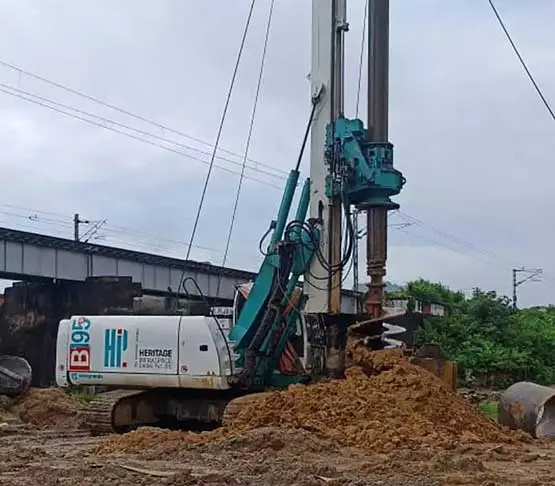
Piling is a kind of deep foundation construction done to transfer and manage the structural load on a deeper level. The piles used in this type of construction are long cylindrical structures made of concrete, wood or steel, pushed into the ground to provide sturdy support to the structures built on it.
The 2 common types of pile foundations done by any piling company in India are End Bearing piles, one where the bottom of it rests on a strong surface by passing the weak and strong layer of soil and Friction piles, which transfers the load of the building to the soil across the full height of the pile, by friction.
Building pile foundations by hiring piling contractors in India is an ideal option when the water table is high and the soil layer on the surface is weaker for more than 2 meters, the structure above has heavy, concentrated loads and the spread footing won’t be able to bear the weight. So the building structure needs to bypass this layer and transfer the weight to the stronger base at depth.
The common types of piling methods used by any piling company in India in construction projects include bored piling, driven piling, micro piling and sheet piling. Bored piling involves drilling holes and filling them with concrete and reinforcement for large and deep foundations. Driven piling utilises prefabricated piles hammered or vibrated into the ground, suitable for cohesive and non-cohesive soils.
In Micro piling, the piling contractors use small-diameter piles for foundation support, often employed in limited-access areas or weak soil conditions, whereas in sheet piling they involve interlocking steel sheets to create retaining walls or stabilise slopes. These methods are employed to provide structural support in challenging soil conditions or transfer loads to stable layers


Piling equipment plays a crucial role in efficient and safe piling operations. Common types of equipment we use include piling rigs, vibro hammers, impact hammers and excavators/cranes. Safety measures are of utmost importance in piling operations and should be implemented by every piling company in India to mitigate risks.
Some of the key safety measures included us are proper training for operators workers and piling contractors in India we ensure the use of personal protective equipment (PPE), site preparation with clear markings and barriers, regular equipment inspections, assessing ground stability, fall protection measures, communication protocols and emergency preparedness. By following these measures, the risk of accidents and injuries can be minimised, ensuring a safe working environment.
Pile foundations offer many advantages, such as being well suited for sites with weak or compressible soils, being able to support structures in seismically active regions or areas with a high water table, being relatively easy to install and being able to support both new construction and existing structures.
Piling is used in construction to provide structural support by driving or drilling long columns, called piles, into the ground. It is necessary when the soil is weak, unstable, or prone to settlement, allowing the weight of the structure to be distributed over a larger area and reach more stable soil or rock layers.
The best soil for piling typically includes stiff clay, dense silt, or well-graded sandy soils. These soils offer good load-bearing capacity and stability, ensuring effective support for the structure. A geotechnical investigation by engineers and piling contractors is necessary to determine the most suitable soil conditions for piling.
They can be rectangular or circular in shape. Their diameter, or size, can vary from 12 to 16 inches. The length of the pile is usually 20 times the top width. They are usually designed for 15 to 20 tons.

©2024. Heritage Infraspace Pvt, Ltd.. All Rights Reserved.